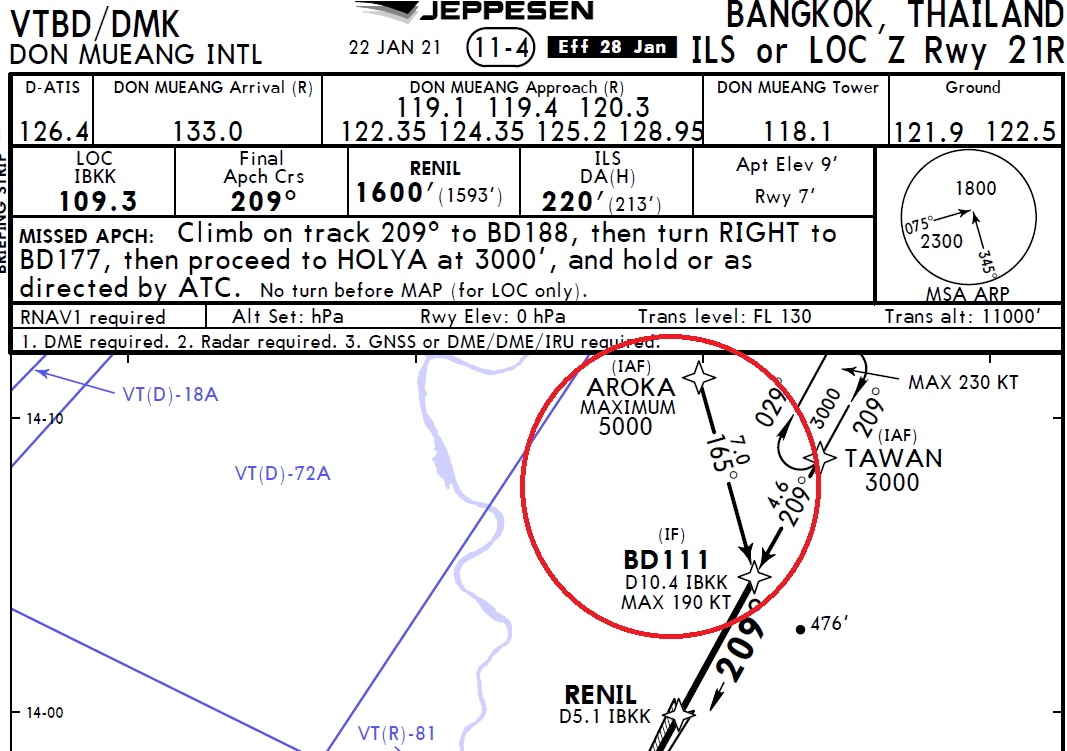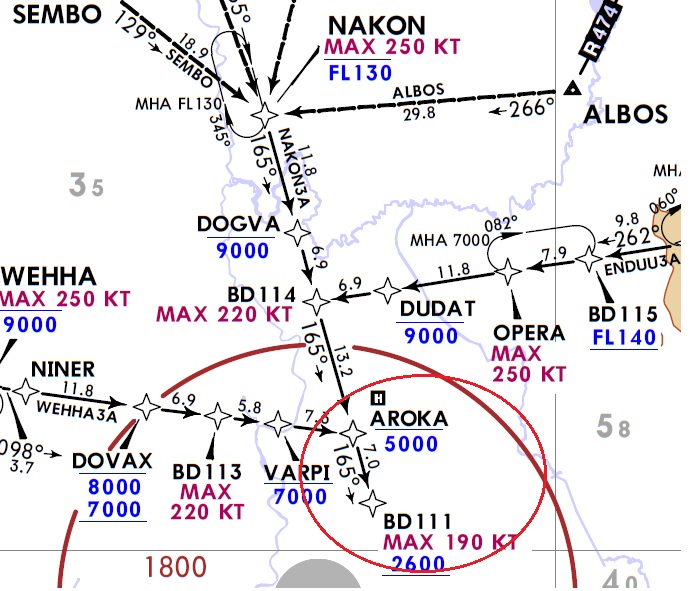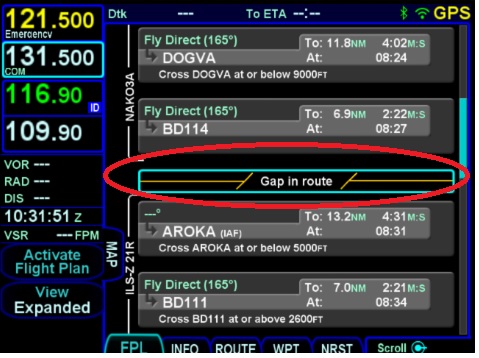Unable to close “Gap in route” arrival and app
Printed From: Avidyne
Category: Avidyne General
Forum Name: IFD 5 Series & IFD 4 Series Touch Screen GPS/NAV/COM
Forum Description: Topics on Avidyne's IFD 5 Series and IFD 4 Series Touch Screen GPS/NAV/COM
URL: http://forums.avidyne.com/forum_posts.asp?TID=2255
Printed Date: 06 Jul 2025 at 4:05am
Software Version: Web Wiz Forums 12.01 - http://www.webwizforums.com
Topic: Unable to close “Gap in route” arrival and app
Posted By: eloigorri
Subject: Unable to close “Gap in route” arrival and app
Date Posted: 16 Sep 2021 at 7:06am
|
Hoping to learn form your collective wisdom. ;-) I am slowly getting to grips with all the functionality available
via the IFD550 I recently installed and I am enjoying the learning experience
as I slowly understand the buttonology and FMS architecture. I recently came across an oddity on an actual flight which I
am sure is just fat finger trouble on my part, but I could not see how to
correct it. Firstly, full disclosure I know the problem is rooted in how my authority/Jeppesen
have coded the overlap between the Nakon3A arrival and ILS Z RW21R into VTBD
but this occurs often over here in Asia so I want to find out the implications and how
to manage the IFD when it happens. If you see the Nakon3A arrival, it ends in AROKA than
BD111 WP’s.
If you look at the actual ILS Z RW21R approach that connects to
this, it duplicates the same two WP’s. AROKA being the IAF, and BD111 the IF.  When the arrival and approach are loaded into the IFD, you get this round robin
that merrily takes you back the way you came due to this overlap. 
This also used to happen in my old GNS units, and I learnt
to delete AROKA and BD111 from the end of the arrival to stop this problem.
After deleting AROKA and BD111 from the arrival section the IFD still maintains
“Gap in route” error with no way to connect back to BD114 the last remaining WP
of the arrival, and so to get around that I manually jumped past the gap by
going direct to AROKA. Is this the only solution?
Cheers - E |
Replies:
Posted By: chflyer
Date Posted: 16 Sep 2021 at 9:31am
|
You might want to check in with pilotsafety.org. Gary Reeves has some interesting videos and courses specifically for mastering the Avidyne units. I'm not certain, but my recollection is that this particular case is covered. I don't know if it is in one his free videos or the Avidyne course. I believe it has something to do with the sequence that the route is built. You've reminded me that it's time for me to also take a look at his videos again. ;-) ------------- Vince |
Posted By: AviSteve
Date Posted: 16 Sep 2021 at 10:41am
|
I suspect that you deleted AROKA from the arrival first and then BD111. There are a few software-related reasons that the FMS wants to keep the first leg of the approach (AROKA) intact. So, when you delete AROKA from the arrival and then delete BD111, the FMS inserts the gap. Deletion of that gap would require insertion of a direct between BD114 and AROKA, but the FMS assumes that an arrival is followed immediately by an approach, so that's why you can't close that gap. However, if you only delete BD111 from the arrival, then you end up with AROKA as the last leg of the arrival, followed by AROKA as the first leg of the approach. The FMS notices this and doesn't insert the gap. In 10.3, this will look slightly different because you'll
actually see both legs. When the
aircraft reaches AROKA, the FMS will sequence both of them and BD111 will be
the active leg. There were a couple of reasons
for this change. First, the old method
of combining the legs at the boundary betweeen the arrival and the approach could
cause some ambiguity in subsequent edits because the FMS couldn't know whether
the pilot wanted the combined waypoint to be part of the arrival or part of the
approach. Second, the new method allows the
pilot to recognize the situation when a common waypoint has differing altitude
constraints. In the picture below, AROKA
has an "at or below 5000" constraint, so there's no gap. However, if the constraints were different,
there would be a gap between the two instances of AROKA. The pilot would then be able to recognize the
issue and resolve the issue, likely by changing the constraint on one of the
legs. ------------- Steve Lindsley Avidyne Engineering |
Posted By: dmtidler
Date Posted: 16 Sep 2021 at 11:37am
|
Short answer: no, this is not the only solution to this arrival issue. Since I cannot find a similar example to test in the North American IFD
database, I also assume that the IFD will not let you delete BD111 on the arrival
without first deleting AROKA on arrival. With this in mind, I’m not aware of
any solutions that would eliminate manually intervening to get the IFD navigating
on the other side of the persistent gap between the arrival and approach. Long answer: IMO, your technique works only because the arrival
course doesn’t change between DOGVA and AROKA. If you are assigned the ENUU3A transition,
your method of solution may not work nearly as well. My take; you may want to consider doing nothing with the
arrival and approach routing as it goes into the IFD leaving both the gap and
overlapping routing. Once the aircraft crosses AROKA on the arrival routing,
perform a Activate Leg to the BD111 waypoint on the approach side of the gap.
This preserves the arrival and overlapping approach routing all the way and
will work for any transition used on this arrival. Your example technique
actually loses the arrival routing between BD114 and AROKA but works because the
arrival course does not change at BD114. With only seven miles between AROKA
and BD111, the IFD will probably be reminding you of the gap ahead before you even
get to AROKA. The downside of this technique is that before the gap, the IFD
will have an extra 14 miles of routing built into it; therefore, along track
distance to destination, ETA at destination, and fuel at destination will reflect
the extra mileage until the active waypoint is sequenced across the gap. |
Posted By: eloigorri
Date Posted: 16 Sep 2021 at 11:56am
|
Many thanks to you all for the detailed replies. @chflyer – Thanks for the pointer to pilotsafety.org. Looks like there is some very useful
knowledge in there. The free video on gaps does cover a similar scenario, but Gary’s
solution of loading the IAF as a wp before loading the destination/procedures does
not work for my particular case. @aviSteve. Correct, I did indeed delete AROKA first followed by
BD111 on the arrival, and trying your suggestion of only deleting BD111 on the arrival
using the 10.3 simulator works as you described. I will try that technique on my actual IFD unit
which is running 10.2.6.1 to see if it works there as well, if not @dmtidler’s
suggestion is almost what I ended up doing today during the flight. It sounds like v10.3 will handle it better
moving forward. Cheers - E |
Posted By: dmtidler
Date Posted: 16 Sep 2021 at 1:09pm
Thanks! I had made an erroneous assumption that deleting BD111 on the arrival hadn't worked; hence the specific order of deleting AROKA before BD111. I could not come up with a North American example to test. I saw the format change playing around with the updated IFD Trainer app and was going to ask about it. BTW - I cannot get the updated IFD Trainer to show any charts. The AUX-Databases Status indicates charts are not installed; however, going through the Databases Update last night appeared to have downloaded the charts effective 9/17 with no effect. My IFD100 now indicates charts effective 9/17 are installed after the IFD Trainer update attempt.
|
Posted By: AviSteve
Date Posted: 16 Sep 2021 at 2:21pm
I moved this to the http://avidynelive.com/forum_posts.asp?TID=2252&PID=26444&title=ifd-trainer-app-for-v10-3#26444" rel="nofollow - 10.3 trainer thread ...
------------- Steve Lindsley Avidyne Engineering |
Posted By: eloigorri
Date Posted: 26 Sep 2021 at 5:08am
|
Just to close this out. On a recent flight, I tested removing the gap by only deleting BD111 from the arrival, and the FMS merged the two AROKA points as AviSteve described. Cheers. E
|



 AviSteve wrote:
AviSteve wrote: